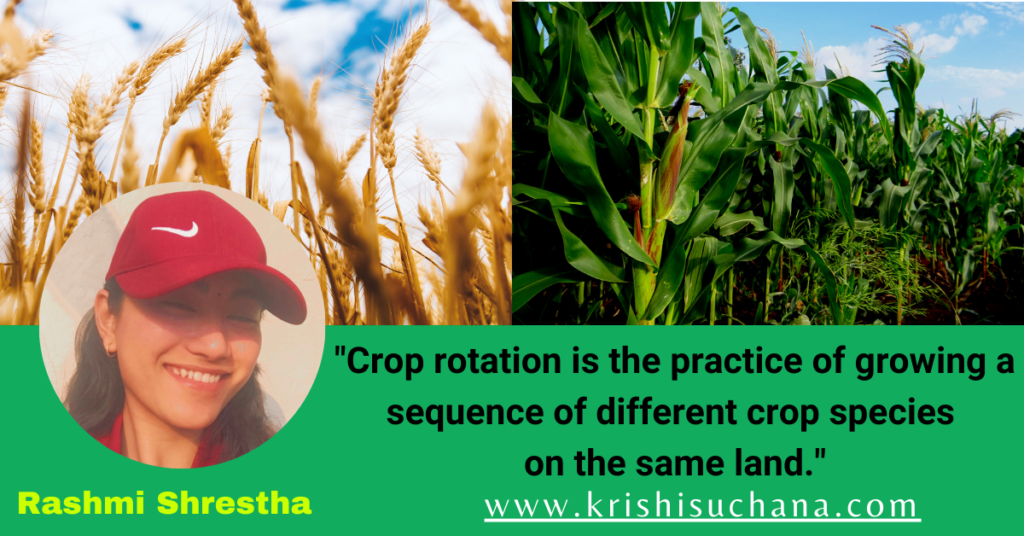Crop rotations sustains cereal yields under changing climates

Abstract
Agriculture is facing the complex challenge of satisfying increasing food demands, despite the current and projected negative impacts of climate change on yields.
Increasing crop diversity at a national scale has been suggested as an adaptive measure to better cope with negative climate impacts such as increasing temperatures and drought. Yield gains in diverse rotations were higher in years with high temperatures and scant precipitations, i.e. conditions expected to become more frequent in the future. Diversified rotations emerge as a promising way to adapt temperate cropping systems and contribute to food security under a changing climate.
1.INTRODUCTION
Crop rotation is the practice of growing a sequence of different crop species on the same land. Crop rotations have been repeatedly shown to be effective methods of minimizing soil erosion, improving water use efficiency, and maintaining high yields. Crop rotation may include two or more crops in sequence over several growing seasons. A two- crop rotation, such as corn and soybean or corn and alfalfa in alternate years, uses the legume to provide
complementary inorganic nitrogen in the soil for the succeeding crops. It makes good sense agriculturally, to
alternate legumes with cereals crops that require large amounts of N.
Global demand for food is predicted to increase by 50%–70% in the coming 40 years. Global trend analyses show that, although yields continue to increase in many regions, almost one third of the growing areas of major staple crops yields either never improved, stagnated or even collapsed. There are multiple causes for these trends, notably climate change, depletion of soil fertility and salinization, soil erosion, pest and disease build-up. In the last decades, cereal yields appeared to be especially sensitive to temperature warming and precipitation deficits.
2. Methods
2.1. Long-term experiments
The yield benefit of the long-term adoption of diverse rotation vs. a cereal monoculture shows a diverse rotation reduced yield sensitivity to temperature warming, precipitation deficits, and their joint effects. Testes for spring (barley and wheat) and winter cereals (oat, wheat and rye), grown under conventional management with optimal applications of mineral fertilizers were done.
2.2. Crop phenology
Climate effects on crop yield to weather conditions occurs during the entire growing season from spring to maturity, and the early (spring growth to flowering) and late (flowering to maturity) parts of this period.
Crop phenology information is a prerequisite for evaluating crop adaptation to climate change, modeling agricultural ecosystem carbon exchange. It is closely related to climate change and is a critical indicator of optimum yield.
2.3.Optimizing Crop Use of Nutrients
Most soils are low in N&P, many are low in Sulphur and potassium and a few fields may be deficient in micronutrients. Soil testing is the best way to optimize crop production by correcting deficiencies. With regard to crop rotations, optimizing crop nutrient use falls under two general headings:
- selecting crops that reduce the need for application of fertilizer
- managing residual soil nutrient levels.
2.4.Crop selection
Easiest way to improve crop nutrient use is to reduce the need for nitrogen (N) fertilizer application by growing
a pulse crop in the rotation. Complementary cropping is one way of improving crop nutrient use that has not received a lot of attention, except among organic producers. One practice under complementary cropping is to rotate between high and low nutrient demand crops in order to slow the development of a nutrient deficiency.
3.CONCLUSION
Crop rotations appears to be a promising measure for sustainable intensification of temperate cereal systems under a changing climate. We show that diversifying crop production at the field scale by adding crop species to the rotation needs to be incorporated in the set of adaptation measures for farmers to adopt. The benefits of growing a diversity of crops are supported by recent advances in plant sciences, showing consistent evidence that increased plant diversity enhances biomass production and stability.
Importantly, a shift of policies and sub-sidies that support widespread adoption of diversification rather than specialization are needed to provide farmers with the means and opportunities to diversify. Therefore, the introduction and adoption of any cropping systems and new technologies must be tested under site-specific conditions and gradually extended from demonstration plots to other regions.
Writer: Rashmi Shrestha (Student, B.Sc.Ag, IAAS, Paklihawa)

